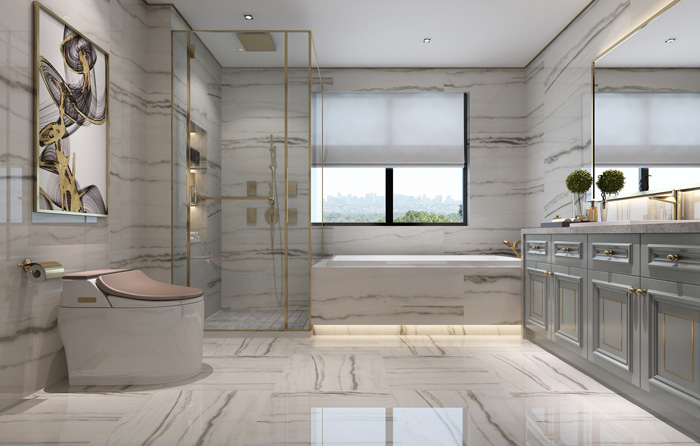Stone has become one of the main choices of modern decoration due to its diverse designs and colors, low profile and luxury. After years of development, it has been widely used. However, in the construction of stone floor decoration, if the construction is improper, it will have a negative impact on the decoration effect. What details should be paid attention to in the construction of stone floor decoration? Next, let's take a look with the small editor of Fabulous Group.

1. Don't forget to soak
Generally speaking, water is the natural enemy of stone. Excessive humidity will cause great harm to stone. There are also many operators who ignore the water immersion operation of stone plates, which is a common misunderstanding in decoration construction.
In fact, the wet pasting of stone must "drink" the stone, so that the cement slurry moisture will not be immediately absorbed by the stone to produce voids, and the floating ash will not affect the overall paving, resulting in reduced overall bonding effect. This is the main factor that causes hollowing of stone.
Therefore, before the stone is laid and used, it needs to be soaked in water, and the back of the stone needs to be wiped with a wet cloth. Only after it is dried can it be used normally.
It should be noted that the specific methods of water immersion treatment are also different for different stone slabs. For example, for water immersion treatment of light-colored and white marble, not only the dust on its back should be cleaned, but also the white cement with anti-alkali primer should be brushed, so as to prevent the ordinary cement mortar from penetrating into the white marble and affecting the effect of color and pattern.
2. Clean stone and ground base
In actual operation, stone products often go through a very long process of mining, processing and repeated transportation before delivery, and are easily contaminated by oil stains, dust and other dirt. In addition, in the ground base, there are often debris such as wood chips, ground ash, soil, oil and so on.
If the operators neglect to check and clean the stone and ground base, the residual dirt will inevitably affect the combination of stone and cement mortar. This will lead to the occurrence of empty drum and other phenomena in the subsequent use process.
Therefore, before installing the stone floor, it is necessary for operators to carefully clean the stone surface and ground base. To this end, the operation team needs to clearly assign this work to specific staff, so that relevant personnel can timely inspect and clean the stone and ground base in the operation area.
In addition to timely cleaning the sawdust, floor ash, residue, oil, etc. to ensure cleanliness, the operators also need to level the verticality and flatness of the surface of the base course, polish the boards with rough surface, and then clean the cement mortar bonded on the base course. In this way, the quality of subsequent projects can be ensured.
3. Use clean water
Whether the stone is soaked in water or mixed with cement mortar, if the water used is not clean, the impurities in the water may react with the stone after paving, resulting in yellow spots, rust spots and other phenomena on the stone, which has a very adverse impact on the overall space effect.
Therefore, in the actual operation process, the operators need to strengthen the management of the water used to ensure that the water used is clear and free of oil, salt, iron powder, sulfur and other substances. It should be noted that water containers also need to be reasonably selected, and iron containers should be avoided to prevent yellow spots, rust spots, etc.
If rust spots have appeared on the plate, it is necessary to select some composite rust remover with good performance to transform iron oxide into inert components while removing the rust spots, so as to prevent rust from occurring in the future. At the same time, after the rust spots are removed, the stone should be waterproof in a timely manner, because too much water is the main inducement for the stone to rust.

4. Reasonable control of water volume
Generally speaking, water, sand, cement and other materials are used for decoration stone pasting. Once the use of cement and water differs greatly, it may affect the compactness of cement mortar.
In addition, if the sand is too fine and the specific surface area is large, it will increase the water consumption of cementitious materials and cubic meter, reduce the strength of mortar, increase the shrinkage rate, and easily cause dry shrinkage cracks or uneven phenomena, resulting in cracks between the granite surface layer and the binding layer. These problems may lead to stone hollowing in future use.
In addition, due to the influence of natural environment, the moisture in the mortar will evaporate, which has a certain impact on the bond strength, making the plate unstable and hollowing. Therefore, in the actual operation process, reasonable control of water volume is very important.
In this regard, operators need to control the water volume in strict accordance with the required proportion of lime and sand during the mixing of cement mortar according to the relevant construction standards. For dry and hard cement mortar, the proportion of cement and sand should be controlled within the range of 1:2~1:3. After mixing, the humidity should be tested by hand. If it can be kneaded by hand, it will be scattered on the ground, and it can meet the requirements of plate laying.
5. Wipe joints after paving
After laying the stone floor, if the operator does not fill and wipe the joints of the plate in time, the later waxing effect may be affected in the subsequent operation process, and the stone plate will be loose after a long time of use.
Therefore, operators need to select suitable mineral pigments and white cement to mix evenly according to the comprehensive analysis of the stone materials and the different colors, and fill them into the gaps between the plates with suitable containers according to the 1:1 slurry ratio.
It should be noted that the spilled mud should be scraped into the gap in time until the gap reaches the closed state. After it is completely diluted, wipe the seam with cotton ball dipped in the original cement slurry to keep it in the same state with the board surface.
6. Line snapping is required when laying plates
The so-called setting out and snapping is a process of transferring the design requirements on the drawing to the actual construction site by using the setting out and snapping tools. Through such a process, operators can check whether the design drawings are in conflict with the specific construction, and whether there are places that are unrealistic or deviated, which is also a further inspection of the design work.
Once there are space errors, restrictions, or omissions in the design at the construction site, if the correct layout is not adopted, the setting out and snapping will directly affect the stone construction quality, especially the uneven patterns and uneven seams at the closing nodes, which will ultimately affect the customer's use and visual effect. Therefore, the setting out and snapping work needs to be highly valued.